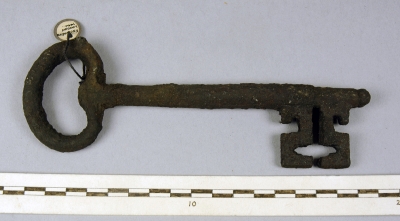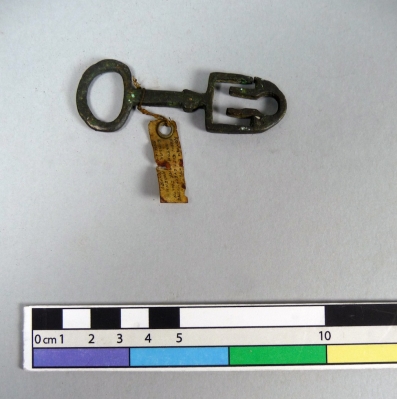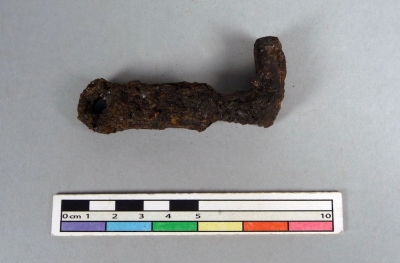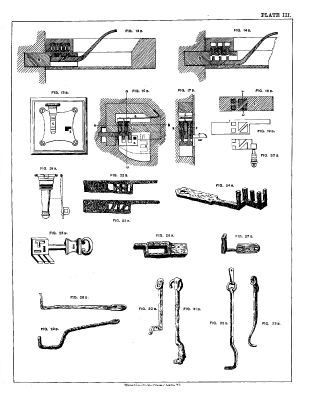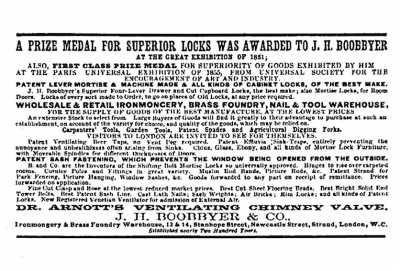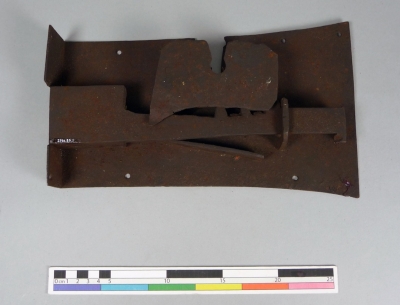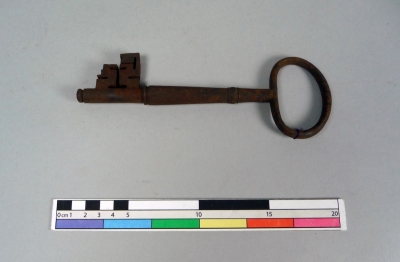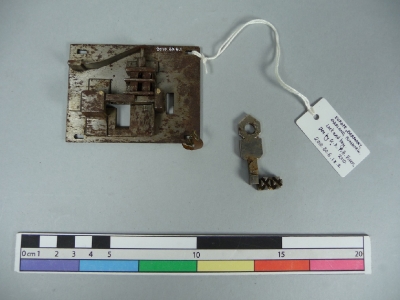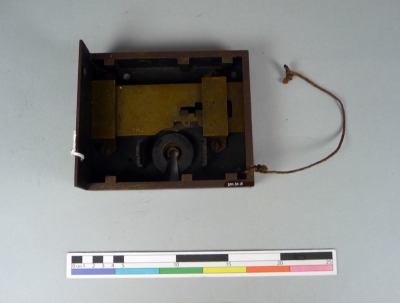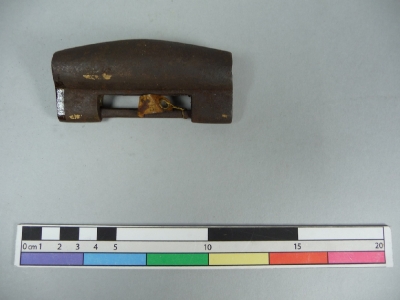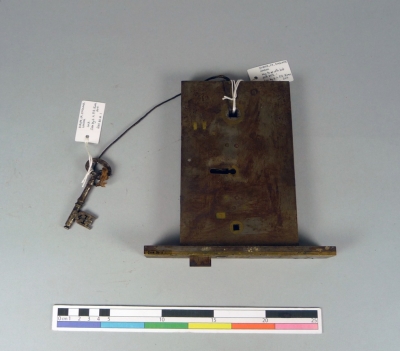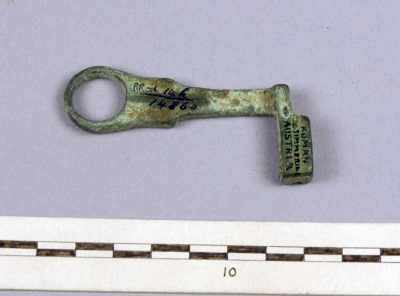To search the RPR site click here
A recent acquisition reuniting with the old
Faye Belsey, Pitt Rivers Museum.
On a mild September day I travelled to Dorset to collect a number of objects previously belonging to Augustus Henry Lane Fox Pitt-Rivers. Kindly offered to the Museum by his great-grandson, Anthony Pitt-Rivers, among these objects were a collection of rather rusted and sorry looking locks and keys, numbering 105 items along with a collection of fine Mexican carved stone figurines (2010.78.1- .38), a pottery pig (2010.81.3) and two pottery lamps (2010.81.1 & .2).
The locks and keys were of particular interest. In terms of learning more about General Pitt-Rivers' collecting habits and theoretical approaches to the evolution of form, locks and keys play a pivotal role. Certainly from around the time he inherited an estate and fortune from his great-uncle, but possibly long before, Pitt-Rivers had been particularly interested in the development of locks and keys. A large number from all over the world, particularly strong areas of representation being Europe and the UK, are to be found in both his second collection and the founding collection housed at the Pitt Rivers Museum, a number of which are displayed in the Lower Gallery of the Museum in Case 72.A & 73.A. Some of the earliest keys in the founding collection are Romano-British, obtained largely from excavations that General Pitt-Rivers would have been well informed of, if not had carried out himself, such as those finds from London Wall. Pitt Rivers excavated part of the London Wall in October - December 1866 at the site of a foundation of a new wool warehouse, the site was 70 x 200 feet. He found fragments of pottery, metal and leatherwork, Roman coins, animal bones (identified by Richard Owen), Augustus Wollaston Franks identified the Roman Samian ware [Chapman, 1981: 249-50] [see Bowden, 1991]. It is possible that 1884.2.30 - .35 were excavated at this time.
Of the 105 locks and keys donated to the Museum in 2010 by Anthony Pitt-Rivers, four are provenanced to London, only two of which are Romano-British; 2010.80.8 ‘Roman Bronze Key found at City Excavations’ (description recorded in the catalogue of the second collection); 2010.80.9 ‘Key found in London (Pitt Rivers vellum label attached to key, it is possible that this key could match with four keys recorded in the catalogue of the second collection of General Augustus Henry Lane Fox Pitt-Rivers held by Cambridge University Library. The possibilities are: "Add.9455vol1_p16 /2 Date: Ditto [1882 May 1] Description of article: Series of Twenty Three (23) ancient Roman Keys. Found in London..." or "Add.9455vol3_p826 /13, 14 & 15 Description of object: Bought at Sotheby’s, Wellington Street, Strand, London... three Roman iron keys..." however the match is not possible due to insufficient information associated directly to the object and lack of illustrations in the catalogue).
Pitt-Rivers' early interest in the development of locks and keys culminated in the publication of On the Development of Primitive Locks and Keys in 1883. Though published ‘late’ in the General’s collecting career it was an important year for progressing towards immortalizing his legacy and establishing the Pitt-Rivers Museum in Oxford, in the previous year he had entered in negotiations with the University of Oxford to establish a Pitt-Rivers Museum and in May 1884 the deed of gift of founding collection to the University of Oxford is signed and locks and keys are a notable part of the founding collection. Though focusing on locks and keys, the volume also hinted at speculative theory of the development and distribution of forms that the General later applied to other examples of material culture and used as a basis to organize the displays at the Pitt-Rivers Museum, Oxford. I think it is worth quoting from Primitive Locks and Keys to highlight this point:
…It is sometimes thought when simple contrivances such as weapons of stone and bronze, some of the simpler kinds of ornaments, and of tools obviously adapted to primeval life are found to extend over wide areas, and in places very remote from one another, that the few ideas necessary for the construction and use of them might easily have suggested themselves independently in different places. To the student of primitive culture who has become impressed with the persistency of art forms, this independent origin of such things does not appear so certain even in the case of the most simple contrivances. But when we come to a complex piece of mechanism, such as a spring padlock having several parts—the spring, the case, the parallel bar, and the key, in all of which the resemblance is maintained in distant countries, and which, with slight modification and continuously progressive improvements, are put together in the same manner in all parts of the world—such a supposition cannot be admitted, the necessity for a common origin is apparent, and the study of the periods and the circumstances connected with the distribution of it cannot be set aside as superfluous.
Assuming that the tumbler pin-lock and the spring padlock cannot be traced back earlier in Europe than the commencement of our era, it is by no means certain that they may not have existed earlier elsewhere. The commerce carried on with the East in early times was of a nature to render it very probable that any contrivance for securing goods should have spread from place to place with the merchandise exported and imported between China, India, and Europe. A brief survey of the trade relations between different countries will be sufficient to show this…” (pp.26 – 27)
The publication is well illustrated with a number of plates. On the opening page of the volume Pitt-Rivers states that:
The materials for this paper, together with the rest of the Museum, have been in course of Collection since the year 1851, and some of the specimens illustrated here have been exhibited to the public at Bethnal Green and South Kensington for some years.
This tells us that from his early days of collecting, functional objects and what he refers to as ‘simple contrivances’ such as locks and keys held a great interest for him. Sadly it is not possible to match most of the objects illustrated to objects in the collections. However, on receiving the 105 locks and keys from the General's original collections I endeavored to match as many as possible to the catalogues of the second collection and the publication. This took a small feat of detective work.
Unfortunately the original vellum labels Pitt-Rivers attached to objects had become stiff and brittle over time and were mostly lost from the locks and keys and those that still had them attached were incredibly fragile and liable to breaking in any attempt to read them. In some cases though, from the information on the vellum labels, it was possible to match objects to catalogue entries and also to illustrations and references in Primitive locks and Keys. This is a credit to the skill of the draftsmen who illustrated the second collection catalogues and the illustrations in the publication. Despite this only 10 keys and locks were found to possibly feature in Primitive Locks and Keys and none of these were found to appear in the second collection catalogues.
Of those matched to the publication, it is possible that 2010.80.67 is one, a Roman key from Switzerland, illustrated in Plate III, Figure 27 B ‘Key to raise a single tumbler lock found at Nonfous, Switzerland, Roman (‘La Ferronnerie’)’. Illustrated in the same plate are a number of Roman keys and tumbler locks from Europe which on page 11 the General goes on to explain the distribution of tumbler locks determined by the localities in which the locks and keys have been found; France, Italy, Germany, Switzerland and England. The key featured as figure 27 B serves to illustrate the type of key adapted to fit single tumbler bolts, and such a bolt is featured alongside it as figure 26 B ‘Bolt for single tumbler found in the Forest of Compiègne, Roman (‘La Ferronnarie’)’, adapted from the Roman keys with teeth designed for bolts with several tumbler holes in them (or it could be said that one type ‘developed’ from the other), as illustrated in the same plate alongside the two keys mentioned.
2010.80.67: though very rusted it is possible that this key is the key illustrated as fig. 27 B in Plate III, shown here:
In terms of being able to match any of the 105 keys from the 2010 acquisition to existing entries in the Cambridge University Library catalogue of the second collection of General Augustus Henry Lane Fox Pitt-Rivers, this proved even more difficult -- only 9 were found to match entries. This was largely possible due to the existing label attached to the object and illustrations in the catalogue. Those that matched were:
2010.80.1 [lock] & 2010.80.7 [key] – The Pitt Rivers Museum label - [Label attached to object on donation to the museum in 2010, now in RDF] LOCK FROM OLD CHURCH DOOR AT SHREWTON PRESENTED BY MR J. BROWN SALISBURY. P. 1013 was found to match the Accession entry - Entry in the Cambridge University Library held catalogue of the second collection of General Augustus Henry Lane Fox Pitt-Rivers volume 3 page 1013, Add.9455vol3_p1013 /6: "Date: Aug. Description of object: Presented by Mr James Brown Salisbury... Lock and key, from an old Church door at Shrewton, Wilts [2 Drawings annotated 1/4] Price: Presented. Deposited at: Removed to: Room 4 drawer under case 13 [in red].
2010.80.2 – The Pitt Rivers Museum label - EUROPE, UK, SCOTLAND, SHETLAND ISLANDS. Wooden chest lock. Don. by G. A. Pitt-Rivers, 2010 was found to match the Accession entry - Entry in the Cambridge University Library held catalogue of the second collection of General Augustus Henry Lane Fox Pitt-Rivers volume 3 page 960, Add.9455vol3_p960 /1: "Date: 1893 June 15. Description of object: [Sale of Bateman Coll: Sotherby] ... Bateman Coll: Sotheby ... Lot 259 Contd A wooden chest lock of Shetland fabric Length 3 7/8 in [Drawing] Price: Lot 259 £2.14. Deposited at: Removed to: Room 4 case 10 [in red].
2010.80.6 .1 & .2 – The PRM label - [broken] Reproduction of Roman lock from materials found at artaunium (Saalburg) Obtained from Homburg was found to match the Accession entry - Cambridge University Library held catalogue of the second collection of General Augustus Henry Lane Fox Pitt-Rivers volume 2 page 254, Add.9455vol2_p254 /14: "Date: Aug & Sept 1886. Description of object: Objects from Homburg ... Reproduction of a Roman lock from materials found at Artaunum (Saalburg) Homburg [Drawing] Price: Deposited at: Museum Lock collection Rm IV Transferred to: Room IV case 10 [in red].
2010.80.8 – The PRM label [mostly illegible] ROMAN BRONZE KEY FROM CITY EXCAVATIONS. HILTON PRICE COLL. SIMILAR TO ENGLISH LATCH KEY matched the Accession entry - Entry in the Cambridge University Library held catalogue of the second collection of General Augustus Henry Lane Fox Pitt-Rivers volume 2 page 47, Add.9455vol2_p47 /4. Date: 28 May 1884 Description of article: Bought of Fenton & Sons, Holywell Street Strand ... Roman Bronze key found in City Excavations [Drawing] Price: Deposited at: Museum Farnham Transfered to: Rushmore 25.9.87 [may only relate to padlock] Added: Room IV case II [in red].
2010.80.12 – The object matched the illustration and information given in the Accession entry Accession entry - Entry in the Cambridge University Library held catalogue of the second collection of General Augustus Henry Lane Fox Pitt-Rivers volume 2 page 251, Add.9455vol2_p251 /4. Date: Aug & Sept 1886 Description of article: Objects from Nuremburg ... A lock and key from Nuremburg [2 Drawing] Price: 14.10 Deposited at: Ditto [P. M. F. Transfered to: Added: Room 4 case 2 [in red].
2010.80.13 – The object matched the illustration and information given in the Accession entry - Entry in the Cambridge University Library held catalogue of the second collection of General Augustus Henry Lane Fox Pitt-Rivers volume 2 page 329, Add.9455vol2_p329 /4. Date: 1887 Description of object: Chinese padlock and key Presented to General Pitt Rivers by John Evans Esq [Drawing] Added note: Accompanying these Padlocks is a letter from Edward Peacock ESq of Bottesford Manor, Brigg, about a lock in his possession with a drawing of the object Price: Deposited at: Museum Farnham (8) Added: Room IV case I2 (no key) [in red]
2010.80.52 – The PRM label Pitt Rivers Museum label - PADLOCK FOUND IN CRANE ST SALISBURY NR THE AUDLEY HOUSE, TO WHICH IT PROBABLY BELONGED. PRES. BY MR J. BROWN [on reverse p. 1013 aw. 194 matched the Accession entry - Entry in the Cambridge University Library held catalogue of the second collection of General Augustus Henry Lane Fox Pitt-Rivers volume 3 page 1013, Add.9455vol3_p1013 /7: "Date: Aug. Description of object: Presented by Mr James Brown Salisbury ... Iron padlock, found in Crane Street, Salisbury, near the old Audley House, to which it probably belonged. Presented by Mr James Brown, South View, Salisbury [Drawing annotated 1/4] Price: Presented. Deposited at: Removed to: Room 4 drawer under case 13 [in red].
The collecting of locks and keys by General Pitt-Rivers reflects the fact that he was an opportunistic collector, taking the opportunity to add to his collection when and wherever possible. Pitt-Rivers holidayed in Germany and Austria in July 1882 and evidently bought a number of objects for his collections on this visit, among them locks and keys. In the founding collection objects with the number 14860 were obtained in Austria and Germany including a bunch of 9 keys; 1884.2.13 .1 - .9.
No provenance is given for this object in the Accession Book. Note that this bunch is probably one of the ones listed on an insert page [between pages 80 and 81] in vol 1 of the Pitt Rivers Catalogues of the Farnham Museum currently housed in the Cambridge University Library Manuscripts room, the page is headed 'List of Articles to go to Museum' as 'Bunch of Roman keys Bronze (11) Simmering Austria'. It was collected by Pitt Rivers during a visit to Germany and Austria in 1882. However only 10 have been tentatively identified. Note that if this identification is right these keys come from Simmering in Austria. ?It is also mentioned on page 85 (including 1884.2.13) with drawing: "Bunch of Roman Keys. 10 in number on Ring. Bronze, Simmering Austria." It is possible that some of the keys with a German and Austrian provenance in the 2010 acquisition were purchased on the same trip.
Pitt-Rivers also collected locks and keys from the usual sources; Auction houses, notably Sotheby’s; 2010.80.2 has written on the object: “LOT 259 SOTHEBY JU:93. BATEMAN COLL: P.960. OLD SHETLAND CHEST LOCK.” Thomas Bateman was, an English antiquary and barrow-digger, his collection was sold by public auction in 1893.
Locks and keys were also purchased from Fenton & Sons, London ‘Dealers of Antiques and Articles of Vertu’. Some of the locks and keys were purchased from James Brown, a resident of Salisbury or Sarum, Wiltshire according to the accession book, his collection was sold, both Goddard and Pitt Rivers bought at that sale.
It would appear that Pitt-Rivers possibly purchased contemporary English locks and keys from locksmiths and hardware stores. A few of the more ‘modern’ (Victorian) English locks in the 2010 acquisition were made by Boobbyers often inscribed as 'BOOB BYER & CO' on the latch, such as the box lock with key 2010.80.14. After corresponding with Brian Moorland, curator of the History of Locks Museum it was interesting the find out that 'Boobbyers were like the B&Q of Victorian times and sold everything from nails to pails in their London store. They also had a large department selling all sorts of patent and branded locks.’ A second lock; 2010.80.16 is inscribed on the latch with 'V R' (Victoria Regina) and crown, 'Detecter Patent' and 'BoobBayer & Sons 14 Stanhope Street, London WC' Like B&Q today some products where the original patent has expired were copied and offered with their own name on, hence the lock clearly marked 'Detector Patent'. Chubb was the most celebrated of the detector locks but other less well known detector patents were by firms like Tann, Marr and Cotterill. Brian Moorland was able to date this lock to the Mid Victorian period.
It is possible with the more modern locks to find out about the manufacturer or origins of the lock from what information is inscribed on the object itself, often patenting information as in the case of 2010.80.15 where the words 'Barron's Patent have been inscribed on the inside and outside of the lock. In 1778, Robert Barron patented the double-acting tumbler lock, the first reasonable improvement in lock security. The tumbler (or lever) falls into a slot in the bolt which will yield only if the tumbler is lifted out of the slot to exactly the right height. As its description suggests, the Baron lock had two such levers, each of which had to be lifted to a different height before the bolt could be withdrawn. Barron's device was developed further in 1818 by Jeremiah Chubb, who incorporated into the lock a spring mechanism which would catch and hold any lever that had been raised too high by a lock picker. Not only did this add another level of security, it showed when the lock had been tampered with.
So the large majority of the 2010 acquisition of locks and keys belonging to the collections of General Pitt-Rivers kindly donated by his Great Grandson Anthony Pitt-Rivers and now amalgamated into the collections of the Pitt-Rivers Museum, Oxford were for the most part not matched to any existing documentation but none the less form an important function in the discourse of Pitt River’s collecting habits and thinking. From the global range and variety of form evident from looking at the assemblage of locks and keys as a whole, especially when reunited with locks and keys from the founding collection it is possible to apply Pitt-River’s theories of development and distribution; the evolution of form through the direct comparison of objects of the same type.
In the Pitt-Rivers papers held at Salisbury and South Wiltshire Museum there are some letters relating to locks and keys which must relate to Primitive Locks and Keys. The first obviously relates to his research:
L86
Chubb & Sons
Lock and Safe Compy Ltd
Patent Safe and Detector Lock Warehouse
128 Queen Victoria Street
London EC
March 21st 1883
Major General Pitt Rivers
4 Grosvenor Gardens
S.W.
Dear Sir,
I am unable to find out where those wooden locks came from today but may perhaps be able to do so in the course of a week or so. I hope to be able to go up & see your collection next week I will then see if we could spare any of our locks, so as to complete your collection, but I have so much pressing work on just now that I am afraid I cannot look into the matter before then.
I enclose an old pamphlet * that may be of some use to you.
I am, Dear Sir,
Yours faithfully
John C: Chubb
Copy of yellow paper-bound pamphlet 'On the Construction of Locks and Keys' by John Chubb, Assoc. Inst. C.E. Institute of Civil Engineering vol IX
And the other two relate to his circulation of the paper to interested colleagues:
L100
Nash Mills. Hemel Hempstead
June 8 1883
My dear Pitt Rivers
I have glanced over your Essay on Locks and Keys which is very interesting You will find a few verbal suggestions and corrections in pencil. ... As to the subject itself you have paid much more attention to it than I have - I am not however sure that the Saxon T ended articles are really keys. They generally occur in pairs and have often their an iron loop connecting them. Was there not some connection between Rome and China for steel? I have an impression that Pliny mentions it - See my Bronze book p. 10 If stell, why not locks. Your Greek words want the accents to be added - I am sorry I have not more time to go into the matter - I called the other morning in the hopes of seeing you but found in were off to Oxford.
[Illegible salutation]
John Evans
L118
124 Buckingham Palace Road
London SW
July 28/ 83
I write to acknowledge the receipt of your admirable monograph on Locks, for which I hope you will accept my very best thanks. It contains an immense amount of valuable information on the subject and being treated from the "development" point of view all the facts fall into their places [insert] so [end insert] naturally and complicated problems assume a simplicity, which must carry conviction, even to such back-sliders as the British Museum authorities, that this is the only rational method to employ. As no doubt you intend to describe other portions of your anthropological collection in a similar way it will help greatly to revolutionise the antiquated systems of arrangement adopted at most museums and make the public take a more intelligent interest in such matters than they do at present.
I am glad to find that you have considered the few notes I sent you of sufficient importance to be commented on and utilised in your book. I venture to enclose one or two remarks on the plates, which illustrate your work, in case the facts I mention may be new to you. When I wrote my paper on wooden locks for the Soc. Ant. Scot. I had not had the advantage of studying your collection, and was only working on the surface so to speak.
I remain
Yrs very truly
J. Romilly Allen
It is likely that he had a much wider correspondence, but it appears this has not survived.
Further Reading
Pitt-Rivers, A.H.L.F. 1883. On the development and distribution of primitive locks and keys: illustrated by specimens in the Pitt Rivers Collection. Chatto and Windus London UK
Locks and Keys Throughout the Ages by Vincent J. M. Eras, 1957
17 February 2012

